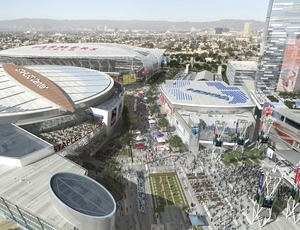

Even in today's corporatized-sports era of millionaire players, billionaire owners and billion-dollar stadiums, sports is deeply embedded in a city's identity. Planners and city boosters inevitably want to harness that emotional connection as an engine of urban development. They have found it is not all that easy to do.
In Cincinnati, a kind of urban glue has begun to develop in the 18 acres of parking lots that divide the city's two venues—the $455-million Paul Brown Stadium for the Bengals and the $337-million Great American Ballpark for the Cincinnati Reds. After about a decade, the first two residential buildings of The Banks, which includes street-level restaurants, extend west from the ballpark. The development will someday include 300 apartments, 300,000 sq ft of office space and a 200-room hotel. The first phase of what will be the 45-acre Phyllis W. Smale Waterfront park nearby on the Ohio River opened last spring.
The riverfront, anchored by stadiums, looks like a textbook case of sports spurring growth—an oft-cited reason for trading in the old venue for a new one. "The stadiums drive tenant interest in The Banks," says Tracy Schwegmann, The Banks' marketing director. "And entertainment attracts retail."
Reds spokesman, Michael Anderson, says the new park gives families "something to do before the game begins."
The costs, however, have been staggering. Though largely underwritten by public funds, the stadiums alone did not spur redevelopment. Overly optimistic financial forecasts have saddled Hamilton County with debt. Though The Banks is built atop a publicly financed parking structure, Carter, the Atlanta-based developer, seemed unconvinced that a prime spot on the riverfront could be a premium location.
The high costs and tepid pace of redevelopment are not unique to Cincinnati; some cities have grown leery of financing big-league sports facilities with public dollars. That complicates the aspirations of team owners and boosters.
The economy plays a part in declining taxpayer support. Governments can't raise taxes and many can't take on more debt. And stacks of independent studies deride the rosy projects underwritten by team owners.
Horror stories abound. Hamilton County, which financed much of both facilities, paid $34.6 million in debt service in 2010, according to the Wall Street Journal. That represents more than 16% of its budget. Juvenile justice services had to be slashed that year.
Tax revenues that back debt have fallen short elsewhere, raising financing costs by $43 million for the NFL Colts' 2008 Lucas Oil Stadium in Indianapolis, according to Bloomberg News.
Still, other cities continue to build.
According to Street & Smith's SportsBusiness Journal, there will be "roughly $9 billion" in sports construction deals on the table over the next five years. The journal estimates that $2.6 billion worth of college facilities are under construction.
The Twin Cities have plans to remodel Target Center arena and build a $975-million stadium for the National Football League Vikings. HKS Inc. is the architect. Chris Hansen, a hedge fund investor from San Francisco, plans to build an arena in Seattle if he can find a basketball tenant. The National Basketball Association's Golden State Warriors have just announced a move from Oakland, Calif., to a planned San Francisco arena under design by Snøhetta with AECOM.
"A sports team seems like such a big deal, but in terms of economic activity it's like a small hospital," Neil deMause, who criticizes public stadium deals in his book and web site, Field of Schemes. "Each new job can cost $250,000; that's a terrible bang-for-the-buck. Economists have found very little impact on sales tax receipts, per capita income, and so on."
These days "finance is much more difficult," says David Stone, who leads the sports practice in the Chicago office of AECOM.
Most of the new facilities are in big-city downtowns because they can add amenity as business districts attract more residents.



Post a comment to this article
Report Abusive Comment